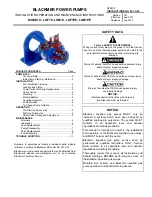
Doc No: OMM50001243
Rev: C Page 20 of 68
This document and all the information contained herein are the confidential and exclusive property of TechnipFMC,
and may not be reproduced, disclosed, or made public in any manner prior to express written authorization by TechnipFMC.
8.0
Estimated Life of Wearing Components
The information given here is an estimate of the average wear life of listed components
in clean liquid service. It is not a guarantee of life for any given application, but is
intended to facilitate maintenance schedules and stocking of spares. The maintenance
of the power end lubrication system will influence the life of the power end components.
The speed of operation and percent of maximum allowable load will influence the life of
both power end and fluid end parts. The temperature, abrasiveness, and lubricity of the
liquid affect the life of fluid end expendables.
POWER END COMPONENT
ESTIMATED LIFE (Hours)
End and Main Bearings (Roller or Ball)
40,000
Wrist Pin Bushings
20,000
Crossheads
20,000
Lubrication pump
20,000
Power End Cover Gasket
10,000
Connecting Rod Bearings
10,000
Crankshaft Oil Seals
10,000
Oil Seal on Plunger (Pony) Rod
5,000
FLUID END COMPONENT
ESTIMATED LIFE (Hours)
Stuffing boxes
16,000
O-Ring Seals
10,000
Valve Assembly
10,000
Packing adapter rings
8,000
Plungers
8,000
Packing
4,000















































